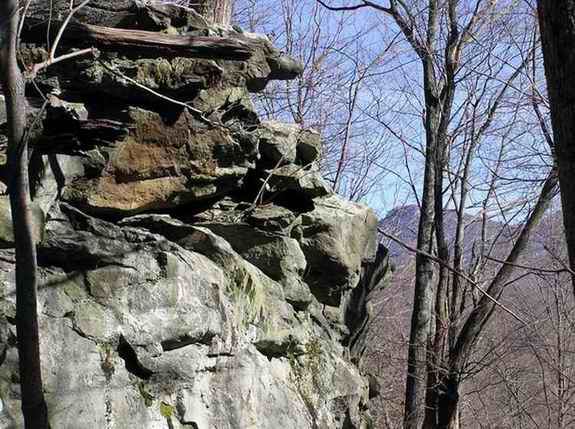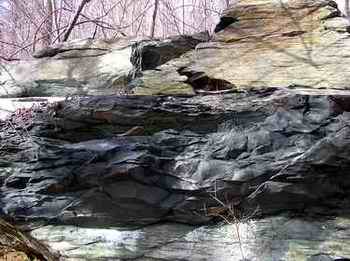|
Catoctin Formation
The Catoctin Formation is named for Catoctin Mountain Ridge that extends from Leesburg to Camp David, as it is that mountain's predominant constituent. Catoctin is of Algonquin origin which at one time was spelled Kittockton. The etymology of the name is not definitive, as "ancient wooded hill", "the land of many deer", and "speckled mountain" have all been cited as the original meaning.
The Catoctin Formation consists of metamorphosed basalt from ancient lava flows with some interspersed sedimentary layers. It can range in depth up to about 2,000 feet. It is the cap formation on most of the higher mountains of the Blue Ridge Province of the Appalachian Mountains.
The geologic theory of plate tectonics accounts for the origin of the Catoctin Formation. About 1.2 Billion years ago, the continents came together to form the supercontinent Rodinia. The collision of the North American Plate with the Eurasian Plate resulted in the Grenville orogeny (from Greek oros [mountain] meaning the formation of mountains through the structural disturbance of the earth's crust). The Grenville Mountains were in essence the proto-Appalachian Mountains and their remnants comprise the plutonic Old Rag Granite and Pedlar Formations.
The continents stopped moving together and began to drift apart about 750 million years ago. It is theorized that this periodic continental separation occurs due to the gradual buildup of heat under the singular continental land mass that acts like an insulator to the molten magma beneath it. As the magma heats up, it rises, pushing the continents apart and spilling out onto the surface in the form of lava flows. In geologic time, the process that formed the Catoctin Formation was protracted, having occurred over a period that extended from about 600 million years ago to 550 million years ago, with perhaps as many as twelve separate events, each event consisting of a feeder dike of molten magma reaching the surface.
The primary constituent of the Catoctin Formation is basalt (from the Greek basanites, a type of slate used to test gold from basanos meaning test). Basalt is a hard, gray to black, extrusive, volcanic rock that is mafic (rich in magnesium and iron and low in silica) in composition. Because of the low silica content, basalt has a low viscosity, so that the lava flow can move relatively quickly and travel as far as 20 kilometers from the source, which can be either a single vent or a long fissure. Basalt is erupted at temperatures that range from 1100 to 1250 degrees Centigrade. Most of the ocean floor is made up of basalt (where the tectonic plates are now separating; the mid-Atlantic ridge is an example) and it is the most abundant volcanic rock in the earth's crust.
The Catoctin Formation has the colloquial name greenstone due to the gray-green coloration of many outcroppings. The Catoctin basalt is comprised of phenocrysts (large crystals) of plagioclase feldspar named albite in a fine-grained matrix of the minerals chlorite, magnetite, actinolite, pyroxene and epidote. Epidote is a structurally complex mineral of calcium, aluminum, iron and silicon [Ca2 (Al, Fe) 3(SiO4)3(OH)] that has a unique green color described as pistachio. It is this mineral that, when present, gives the Catoctin Formation a distinctive greenish hue.
The sequential lava flows over an extended period are reflected in the
diversity of the Catoctin |

 Formation. The boundaries between the lava flows are marked by breccias,
metatuffs, and metasandstone. Breccia is a rock comprised of a smaller rock
fragments cemented together by sand, clay and/or lime. These rocks identify
areas where a crust formed on a lava flow that was disrupted by subsequent
flows. A tuff is a porous rock created by a consolidation of volcanic ash.
The metabolized tuffs, or metatuffs, are attributed to a rapidly moving cloud
of molten ash. The metabolized sandstones, or metasandstones, mark the
boundary between one lava flow, a period of erosion and sedimentation, and a
second lava flow.
Formation. The boundaries between the lava flows are marked by breccias,
metatuffs, and metasandstone. Breccia is a rock comprised of a smaller rock
fragments cemented together by sand, clay and/or lime. These rocks identify
areas where a crust formed on a lava flow that was disrupted by subsequent
flows. A tuff is a porous rock created by a consolidation of volcanic ash.
The metabolized tuffs, or metatuffs, are attributed to a rapidly moving cloud
of molten ash. The metabolized sandstones, or metasandstones, mark the
boundary between one lava flow, a period of erosion and sedimentation, and a
second lava flow.